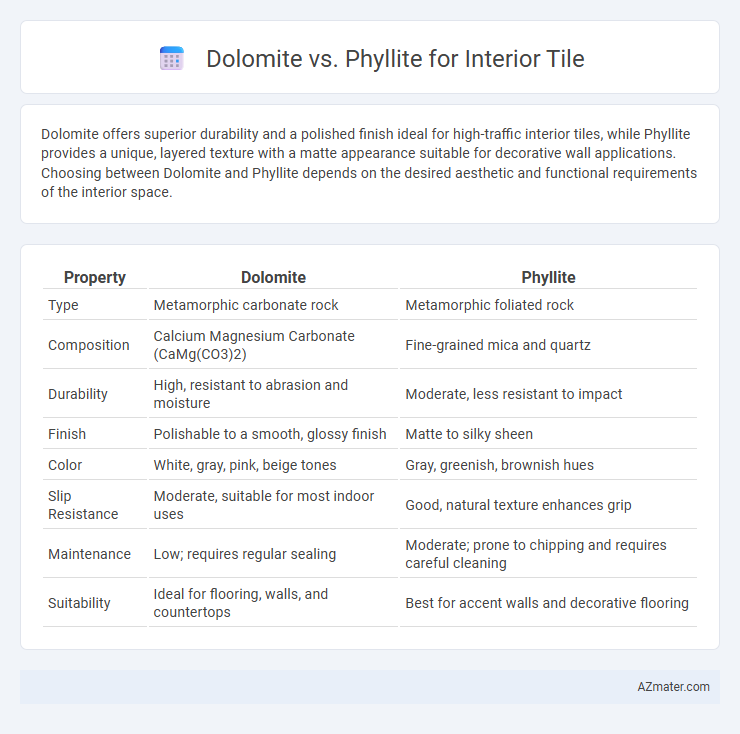Dolomite offers superior durability and a polished finish ideal for high-traffic interior tiles, while Phyllite provides a unique, layered texture with a matte appearance suitable for decorative wall applications. Choosing between Dolomite and Phyllite depends on the desired aesthetic and functional requirements of the interior space.
Table of Comparison
| Property | Dolomite | Phyllite |
|---|---|---|
| Type | Metamorphic carbonate rock | Metamorphic foliated rock |
| Composition | Calcium Magnesium Carbonate (CaMg(CO3)2) | Fine-grained mica and quartz |
| Durability | High, resistant to abrasion and moisture | Moderate, less resistant to impact |
| Finish | Polishable to a smooth, glossy finish | Matte to silky sheen |
| Color | White, gray, pink, beige tones | Gray, greenish, brownish hues |
| Slip Resistance | Moderate, suitable for most indoor uses | Good, natural texture enhances grip |
| Maintenance | Low; requires regular sealing | Moderate; prone to chipping and requires careful cleaning |
| Suitability | Ideal for flooring, walls, and countertops | Best for accent walls and decorative flooring |
Introduction to Dolomite and Phyllite Tiles
Dolomite tiles, derived from a sedimentary carbonate rock composed primarily of the mineral dolomite, are prized for their durability and natural resistance to abrasion, making them an excellent choice for high-traffic interior flooring. Phyllite tiles, formed from fine-grained metamorphic rock featuring a distinct foliated texture and a silky sheen, offer unique aesthetic appeal with their varying hues of gray, green, and purple, adding elegance to wall cladding and decorative surfaces. Both tile types provide distinct mineral compositions and structural characteristics that influence their suitability for different interior design applications.
Geological Origins and Composition
Dolomite, a sedimentary carbonate rock primarily composed of calcium magnesium carbonate, forms through the diagenesis of limestone in shallow marine environments, resulting in a dense, crystalline texture ideal for interior tiles with high durability. Phyllite, a metamorphic rock derived from the low-grade metamorphism of shale or mudstone, consists mainly of fine-grained mica minerals such as sericite and chlorite, giving it a foliated texture and a distinctive sheen suitable for decorative interior tiling. The geological origins of dolomite provide superior chemical stability and hardness, while phyllite's metamorphic formation offers unique aesthetic qualities but lower resistance to abrasion in interior tile applications.
Aesthetic Differences: Color and Texture
Dolomite tiles typically exhibit a light to medium gray color with subtle veining, offering a sleek and uniform appearance ideal for modern interior designs. Phyllite features a richer color palette, ranging from greenish-gray to dark silver with a natural sheen and foliated texture, providing a more rustic and dynamic aesthetic. The distinct textures of Dolomite's smooth surface contrast with Phyllite's layered, slightly rough feel, influencing the choice based on desired interior ambiance and visual impact.
Durability and Hardness Comparison
Dolomite exhibits higher hardness, typically ranging from 3.5 to 4.5 on the Mohs scale, making it more resistant to scratches and wear compared to phyllite, which rates around 2 to 2.5. In terms of durability, dolomite's dense crystalline structure provides excellent resistance to chipping and erosion, ideal for high-traffic interior tile applications. Phyllite's foliated texture offers moderate durability but is more prone to surface scratches and moisture penetration, requiring additional sealing for longevity.
Water Absorption and Stain Resistance
Dolomite exhibits low water absorption rates, typically below 0.1%, making it highly resistant to water damage and ideal for interior tile applications in moisture-prone areas. Phyllite, with its slightly higher porosity, generally shows greater water absorption, around 0.5% to 1%, which can increase susceptibility to staining without proper sealing. The superior stain resistance of dolomite compared to phyllite ensures easier maintenance and longer-lasting aesthetic appeal in interior tile installations.
Installation Requirements and Techniques
Dolomite tiles require precise cutting tools due to their hardness and density, necessitating diamond blades and slower cutting speeds to prevent chipping during installation. Phyllite, being a softer metamorphic rock, allows for easier handling and shaping but demands careful sealing to protect against moisture penetration, especially in high-humidity environments. Both materials benefit from a flat, stable substrate, but phyllite tiles require additional attention to grout selection to accommodate their slightly porous surface and prevent staining.
Maintenance and Cleaning Needs
Dolomite tiles offer low maintenance with their dense composition resisting stains and requiring only regular sweeping and occasional mopping using pH-neutral cleaners. Phyllite tiles, characterized by their foliated texture and mica content, demand more careful cleaning to avoid surface scratches and discoloration, best cleaned with mild detergents and soft cloths. Both materials benefit from periodic sealing, but dolomite typically has longer intervals between resealing compared to the more porous phyllite, affecting long-term maintenance efforts.
Cost Analysis: Dolomite vs Phyllite
Dolomite tiles typically cost more than phyllite tiles because of their higher durability and polished finish, making them ideal for high-traffic interior areas. Phyllite offers a more affordable option, with moderate hardness and a matte surface that suits decorative applications without demanding heavy maintenance. Budget-conscious projects often prefer phyllite for its cost-effectiveness, while premium interiors justify the investment in dolomite for long-term value.
Eco-Friendliness and Sustainability
Dolomite and phyllite differ significantly in eco-friendliness and sustainability for interior tile applications. Dolomite, a sedimentary carbonate rock, often requires less energy-intensive processing and emits lower carbon during quarrying compared to phyllite, a metamorphic rock with a foliated texture that may demand more intensive cutting and finishing. Both materials are durable and natural, but dolomite's lower environmental impact in extraction and processing makes it a more sustainable choice for eco-conscious interior tile projects.
Best Uses and Design Applications
Dolomite offers high durability and a polished finish, making it ideal for flooring and wall tiles in high-traffic interior areas such as kitchens and bathrooms. Phyllite, with its smooth texture and subtle sheen, excels in decorative accent walls and backsplashes, providing a soft, natural aesthetic suited to modern or rustic designs. Both stones provide versatile color options, but Dolomite's hardness better resists scratches, while Phyllite's lightweight composition simplifies installation in vertical applications.

Infographic: Dolomite vs Phyllite for Interior Tile
 azmater.com
azmater.com